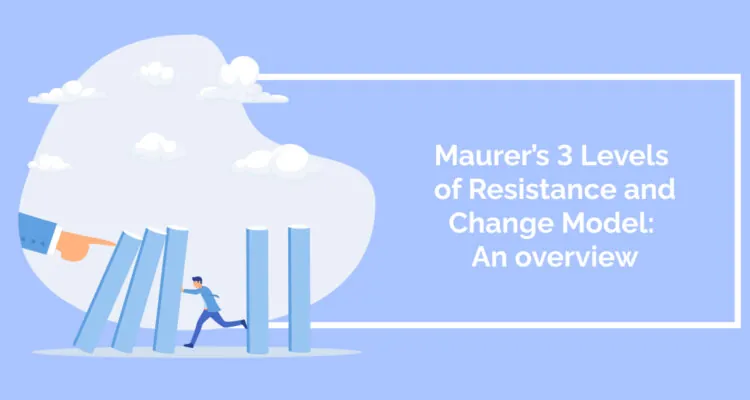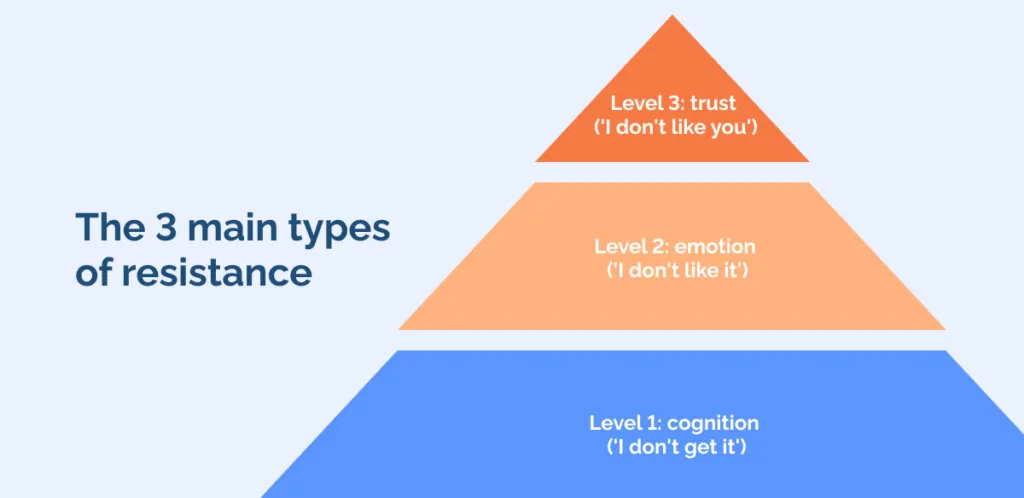
Organizational change manifests in various forms, including strategic, leadership, or technological shifts.
Recently, the role of a change management life cycle in facilitating these changes has become increasingly significant.
Change management is a strategic process focused on aiding the people aspect of organizational transitions.
It primarily assists employees in understanding, committing to, accepting, and adapting to changes within their business environment.
A notable model in this field is Rick Maurer’s 3 Levels of Resistance and Change Model, which highlights the importance of addressing resistance in change implementation.
According to Maurer, understanding and promptly addressing resistance can prevent derailment of the change process.
He identifies three core reasons for resistance: lack of understanding of the change, dislike for the change, or distrust towards the change initiator.
Recognizing the specific cause of resistance is crucial, as each situation demands a tailored approach for proactive change management.
By the end of this guide, you will understand:
- What the Maurer’s 3 Levels of Resistance and Change Model is
- The 3 levels of resistance and how to tackle each one
- The benefits and challenges of the model
What is the Maurer 3 Levels of Resistance and Change Model?
In his book ‘Beyond the Wall of Resistance,’ Rick Maurer introduces the 3 Levels of Resistance and Change Model, which outlines three primary forms of resistance encountered during change.
These include cognitive resistance (lack of understanding, or ‘I don’t get it’), emotional resistance (dislike of the change, or ‘I don’t like it’), and resistance stemming from distrust (dislike of the change leader, or ‘I don’t like you’).
Each type of resistance necessitates a unique approach from the change manager. This model helps identify why key stakeholders may not yet be supportive, devise strategies to engage specific stakeholders at various stages of the change process, and craft targeted communications tailored to different groups of stakeholders.
What are the 3 levels of resistance of this model?

When addressing the types of resistance to change, it is essential to remember that employees could display more than one level of resistance. This means that all suggestions for the level could be used to build support for a change.
Addressing resistance effectively involves starting at the first level and attempting to resolve it there.
If, after thorough efforts, resistance persists, it’s prudent to consider that a higher level of resistance might be at play, prompting a shift in approach.
Let’s dive further into the 3 Levels of Resistance in the Maurer Model, as well as the possible solutions for each level:
Level 1: cognition (‘I don’t get it’)
Meaning
This level primarily concerns the lack of information, interpretation disagreements, or integration confusion.
The initial strategy involves providing clear information, logical explanations, and guidance. This approach can be effective in encouraging acceptance of the change.
However, it’s a misconception to think that all resistance can be overcome solely with information and logic.
When resistance persists despite clear explanations, it might not reflect our explanatory skills but rather indicate a deeper level of resistance requiring a different approach.
Solution
When tackling Level 1 resistance, which revolves around informational or logical misunderstandings, reevaluate your communication strategy with your audience in mind. Simplify your language, remove technical jargon, and consider using visual aids like pictures, models, slides, or even on-site demonstrations for clearer understanding.
Emphasizing clear, reciprocal communication is crucial at this stage. This might entail creating concise presentations or emails, substantiating the benefits of the change with data, and facilitating Q&A sessions after communicating the change.
These steps allow for open dialogue and constructive feedback, enhancing the likelihood of overcoming resistance at this initial level.
Level 2: emotion (‘I don’t like it’)
Meaning
This level is characterized by emotional responses to change, such as fear of losing status, annoyance about exclusion from the decision-making process, or difficulty grasping complex changes. This resistance is especially prevalent among those with negative past experiences of change.
In organizations, leaders might misinterpret emotional resistance as informational resistance. Addressing this level effectively involves acknowledging the emotional concerns as legitimate and allowing time for individuals to process these emotions before expecting them to adapt.
Solution
In many organizations, emotional responses are not openly encouraged, leading employees to express their concerns under Level 1 (informational) issues.
They might ask about budgets and timelines, appearing to agree, but they could harbor unspoken fears and emotional concerns.
To effectively address this level of resistance, it’s important to emphasize the advantages of the change for individuals.
People are more likely to embrace change if they see a personal benefit, such as easier work processes, improved relationships, better career opportunities, or enhanced job security.
In addition, employee engagement is critical. When people contribute to shaping a change, they are more likely to support it. If someone points out a problem with the change that can be fixed, acknowledge it and commit to addressing it promptly.
Follow up with them once the issue is resolved, demonstrating their input is valued.
Next, if the change includes negative aspects, such as layoffs, be upfront about it.
Being transparent can increase trust in you as a leader, which is crucial in avoiding Level 3 (personal) resistance. By addressing concerns honestly, you show respect for employees and their ability to handle difficult information, fostering a more trusting and open environment.
Level 3: trust (‘I don’t like you’)
Meaning
Unlike the first two levels of the change, Level 3 resistance is personally centered on the individual proposing the change. It is influenced by the proposer’s history with the audience and their biases, prejudices, or mistrust.
This form of resistance is particularly challenging because it requires the proposer to acknowledge that some people may not like or trust them.
Denying or ignoring this resistance can hinder the advancement of ideas. To effectively manage Level 3 resistance, it’s crucial to empathetically view oneself from others’ perspectives, understanding how they perceive and hear them.
Solution
Trust, once lost, is challenging to regain. It’s essential to cultivate trust proactively, whether building it from scratch, repairing it, or dealing with a legacy of low trust in your current situation. Adopting an ethical leadership perspective and understanding how others perceive you and your ideas are crucial to building or rebuilding trust.
Once you have this understanding, follow it up by engaging in dialogues rather than monologues.
Ask questions to understand the reasons behind opposition to your idea. Pay close attention to what others say, not just in words but also through their body language and actions.
Then, avoid defensive attitudes, sarcastic remarks, or agreeing without genuine agreement. These reactions can hinder trust-building and effective communication.
Finally, show your listening and understanding by paraphrasing others’ concerns. Be open to ideas that build upon or improve your own, demonstrating that collaboration is welcome.
Emphasize that there is space and opportunity for others to join and contribute to implementing the idea. You create an inclusive environment that fosters trust and cooperation by validating and incorporating others’ input.
Benefits of the Maurer 3 Levels of Resistance and Change Model
Resistance to change often stems from how the change is implemented. Understanding this resistance is vital to fostering support for change. A primary advantage of the Maurer 3 Levels of Resistance and Change Model is its emphasis on active listening: genuinely listening to those you aim to change is crucial.
While it’s easy to assume you understand their thoughts and concerns, misunderstandings are common. The principle of ‘seek first to understand, then to be understood’ is vital.
Furthermore, the model encourages transforming opposition into support. You can adapt your training and resistance management plans by comprehending the specific resistance obstructing your ideas.
For instance, altering your communication style or language might make your explanation more relatable and transparent if someone doesn’t grasp your change initiatives.
Challenges of the Maurer 3 Levels of Resistance and Change Model
Like any change management strategy, the Maurer 3 Levels of Resistance and Change Model encounters specific challenges, mainly when dealing with large groups or extensive organizational changes.
One significant limitation is the time it could take to overcome resistance in larger groups. Instead, McKinsey’s 7-S Framework or Kubler-Ross’ Change Curve might be a better fit.
Furthermore, the model might offer limited solutions to mitigate resistance in scenarios such as a company acquisition where existing employees may dislike the new leadership.
Additionally, outcomes at each resistance level are not always controllable. For example, despite addressing every concern or hesitation, there’s no certainty that an individual will embrace the change.
This is akin to encouraging a new customer to purchase a product; even if you effectively address their apprehensions and needs, it doesn’t guarantee a sale.
Lastly, like most change management models, it cannot work independently as there are no defined steps to effect change or create a strategy. Maurer’s 3 Levels of Resistance and Change Model could work well with Kotter’s 8 Steps Model or Bridges Transition Model, which gives an organization steps to follow for a successful change.
What’s next for Maurer’s 3 Levels of Resistance and Change Model?
Maurer’s 3 Levels of Resistance and Change Model, developed by Rick Maurer, emphasizes the reasons behind the failure of changes. It identifies three primary resistance levels: ‘I don’t understand it,’ ‘I don’t agree with it,’ and ‘I don’t trust you.’
Maurer theorizes that most significant changes falter due to insufficient information, negative emotional responses to change, or a lack of trust and confidence in those leading the change.
While this model is most effective when combined with a detailed change management plan, recognizing and addressing these types of resistance can be highly beneficial for organizations.
Regardless of the change management model selected, sustained support during a transition is crucial, particularly for substantial changes like implementing new software.
Utilizing appropriate change management tools can assist in securing the necessary support for significant organizational transformations.
WalkMe Team
WalkMe spearheaded the Digital Adoption Platform (DAP) for associations to use the maximum capacity of their advanced resources. Utilizing man-made consciousness, AI, and context-oriented direction, WalkMe adds a powerful UI layer to raise the computerized proficiency, everything being equal.



